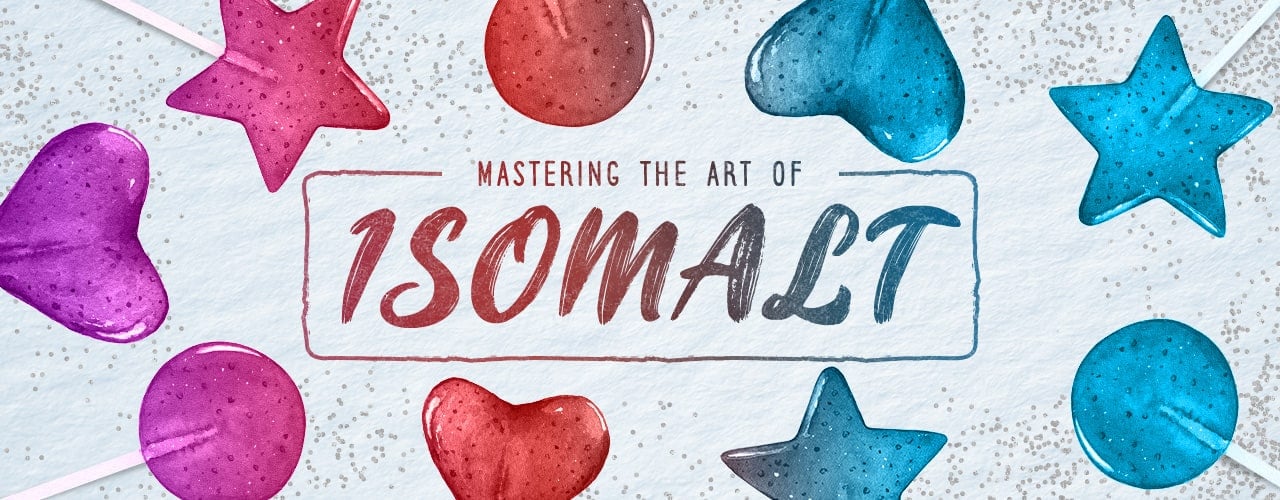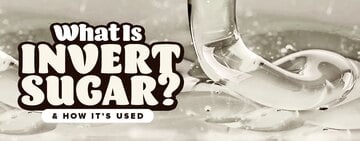Isomalt is a baking term that refers to a sugar substitute made from sugar alcohol instead of real sugar. Unlike regular sugar, isomalt is resistant to humidity due to its unique chemical structure, giving it a huge advantage when used in confectionary work. It can also be used as a sugar substitute in sugar-free candies and syrups, providing a low-calorie alternative for those with dietary restrictions. Whether you're a seasoned professional or a passionate home baker looking to elevate the presentation of your creations, isomalt can open up a world of possibilities in the world of confections.
Shop All IsomaltWhat Is Isomalt Made Of?

Isomalt is made from glucose, mannitol, and sorbitol, which are all carbohydrates that fall into types of sugar alcohols. Sugar alcohol, or polyols, are a type of carbohydrate that have structures that resemble both sugar and alcohol.
These three sugar alcohols are two different mixtures of disaccharides. The first disaccharide is glucose and sorbitol, and the second disaccharide is glucose and mannitol. After the two disaccharides are mixed, they are then transformed into isomaltulose and then hydrogenated into isomalt. Therefore, isomalt is made from 50% glucose, 25% mannitol, and 25% sorbitol.
Isomalt vs Sugar
While they may seem similar, isomalt and sugar are very different. Isomalt is completely sugar-free and therefore can be ingested by diabetics and won't cause tooth decay. Isomalt also has about half of the sweetness that sugar does and is lower in calories.
Isomalt has a much higher resistance to crystallization and humidity when compared to sugar. Unlike sugar, isomalt does not caramelize as easily and can keep its clear color up until it reaches 400 degrees Fahrenheit.
How to Use Isomalt

When cooked properly, isomalt can be poured, pulled, blown, and pushed to create a myriad of shapes and intricate details. With so many different ways to use isomalt, you’ll be able to create various confections to elevate your offerings. Here are popular ways to use isomalt:
- Sugar sculptures
- Cake decorations
- Sugar-free candy
- Sugar-free chocolates
- Chewing gum
Isomalt Benefits
There are many benefits to using isomalt instead of sugar. Here are just a few ways isomalt is easier to work with:
- Higher resistance to crystalization
- Higher resistance to humidity
- Stays colorless up to 400 degrees Fahrenheit and can accept food coloring
- Remains odorless and can be flavored
- Is sugar-free and can be digested by diabetics
- Does not cause tooth decay and is considered to be tooth-friendly
- Can be remelted to produce new sugar work or decorations
Isomalt Substitutes
While isomalt and granulated sugar can be used as direct replacements for confections such as sugar sculptures or candy work, isomalt cannot be used as a direct replacement for sugar in baking because isomalt is not meant to be ingested in large quantities.
Where to Buy Isomalt
Isomalt is sold in specialty baking stores or online on restaurant retail websites. Before you purchase, consider whether you will need isomalt sticks, isomalt crystals, or isomalt nibs. Isomalt sticks and isomalt nibs are already cooked for extra convenience. Isomalt crystals do need to be cooked properly but are much less expensive than isomalt nibs or isomalt sticks. You can add food coloring and flavorings to isomalt nibs and sticks once they are remelted, and some even come with colorings already added for further convenience.
Isomalt FAQs

Because isomalt sugar is such an uncommon ingredient to new and non-bakers, questions are bound to arise all about the sugar substitute. Below we have gathered questions you may have about isomalt sugar:
Is Isomalt Edible?
Isomalt is fine to be eaten in moderation. However, it is not suitable to be eaten in large quantities. Never replace sugar with isomalt when baking pastries or bread. The reason isomalt cannot be ingested in large quantities is that sugar alcohols cannot be fully absorbed in the lining of the body’s intestine. This would cause gastrointestinal distress and give your customers a very upset stomach.
Is Isomalt Safe?
Isomalt is safe to use if handled properly. It’s important to remember that hot isomalt is the equivalent of hot sugar and should be molded with caution. Many chefs recommend wearing three to four pairs of rubber gloves when handling hot isomalt, as well as wearing long sleeves to protect your arms from any splattering that may occur during the cooking process.
Is Isomalt Keto Friendly?
Yes, isomalt is keto-friendly. Most sugar alcohols are keto-friendly as they’re low on the glycemic index, so they will not spike your blood sugar levels and take you out of your ketosis.
Does Isomalt Have a Scent?
Isomalt is an odorless sugar substitute. This makes it perfect for letting the natural scent and taste of the flavors in your creation stand out on their own, or adding your own flavorings to the isomalt for a heightened experience!
What Does Isomalt Taste Like?

In terms of taste, isomalt has a mild, sweet flavor that is similar to regular sugar. However, it is important to note that isomalt is not as sweet as sugar, so you may need to adjust the amount used in your recipes accordingly. Some people describe the taste of isomalt as slightly caramel-like or with a hint of butterscotch.
Does Isomalt Change Colors?
Isomalt starts to change colors, or caramelize, when it reaches 400 degrees Fahrenheit. Below that temperature, isomalt will remain colorless. However, you can add color to isomalt with food coloring.
Which Food Coloring Can I Use with Isomalt?
You can color isomalt with gel, liquid, or powder food coloring. If working with gel or liquid colorants, be aware that the isomalt will bubble up once the food coloring has been added.
What Is Isomalt Syrup?
Isomalt syrup is a versatile and popular sweetener used in a wide range of commercial applications. Isomalt syrup also has a high resistance to crystallization, which is particularly advantageous when it comes to making sugar sculptures and decorative pieces. Its low viscosity allows for easy pouring and molding, while its resistance to humidity ensures that your creations maintain their shape and clarity for longer periods of time.
How Should I Handle Isomalt?
When handling isomalt, especially if adding food coloring, be sure to use long spatulas, wear sleeves to protect your arms, and 3 to 4 four pairs of rubber gloves.
How Do I Store an Isomalt Creation?
Your isomalt creation or sugar sculptures can be stored in an airtight container at room temperature for four days. Some professional pastry chefs will store them with a packet of desiccant to absorb moisture to keep the sugar sculpture or isomalt candy creations intact.
Isomalt is a versatile sugar substitute that has a wide range of commercial applications. If you’re looking to start a bakery, understanding how to use isomalt is critical to creating well-designed baked goods. Its unique properties make it an ideal choice for creating decorative elements and enhancing the visual appeal of various foods. Whether it's adding a touch of artistry to a cake or working as a substitute in sugar-free items, isomalt proves to be a reliable and innovative solution.



